64 Brunswick Street West, Hove
64 Brunswick Street West sounds like an ordinary address for an ordinary building. Yet 64 is, in many ways, quite extraordinary. It is architecturally the most imposing building in the street, it is the only “listed” building in the street and it has a rich and varied history. The building (pictured below) is situated on the west side of the street about 50’ south of busy, commercial Western Road and currently (in 2022) houses the Brighton HQ of BIMM (British & Irish Modern Music Institute). It is in fact the second building to be constructed on this site (the first was demolished in 1855) but together these two buildings have a unique and varied history stretching all the way back to 1831.
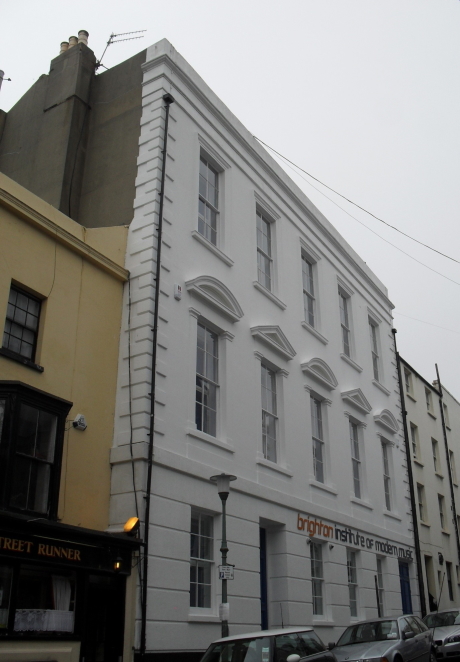
The Old Hove Town Hall in the 2020s
If the site and building were a person it could be said to have gone through three ages:
(Age 1) 1831-55 when it was the Brunswick Estate Commissioners’ Building & Police Station.
(Age 2) 1856-82 when it was rebuilt and became the first Hove Town Hall.
(Age 3) 1882 to the present shorn of its municipal functions it sought and found a wide range of commercial, social, institutional and even spiritual purposes.
1831 - 55
From its early years, Brunswick Town was managed and administered by a group of Commissioners and in 1831 they organised the construction of a new and much needed building. It was to be built on the west side of Brunswick Street West on a plot of land purchased from Charles Busby himself. The building opened in September 1831 and consisted on the ground floor of a well and space for water carts and a fire engine. On the first floor there was a water tank (for the carts), accommodation for a Watchman and the Commissioners’ Meeting Room. It was - in all but name - the Brunswick Town Hall and over the next 20 plus years it functioned as: Police Station, Fire Service Station and the Brunswick Commissioners’ HQ, and held the carts for watering the streets.
Advert for ‘Watering the streets’ - Brighton Guardian - 14 March 1832
1856 – 82
Hove’s housing and population grew so considerably in the middle decades that in 1855 the original building plus Mr Martin's house next door were demolished and a replacement was constructed on a slightly expanded site - extended by an extra 15’ of frontage to the South. This was the very first “Hove Town Hall” and it accommodated: the Police Station, the Fire Station and the Law Courts and was in essence the building that exists to this day.
1882 to the Present
By the late 1870’s the population of Hove had expanded to such an extent that Hove Town Hall required much larger premises. Alfred Waterhouse was commissioned to design a new Hove Town Hall and this time it was to be on a different site - in Church Road. This edifice, a magnificent piece of Victorian Gothic that opened for business in 1882, brought to an end the Brunswick Street West building’s municipal function.
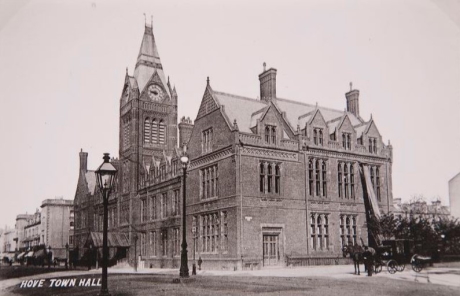
Alfred Waterhouse’s ‘New’ Hove Town Hall
Perhaps the building lay empty for a while but for the next 40 years or so, the two floors of the building housed a startlingly varied succession of different enterprises including: The Brighton Pelican Club, Auction Rooms, The Brighton Motor Mart, The Catholic Women’s League and The Hove Society of Spiritualists.
Who Lived in this Building?
It was never primarily a residential building and so a relatively small number of people have actually lived in the building. There was however, from the very start, some residential accommodation on the first floor and for much of the first 40 years that accommodation was occupied by George Breach and his family. George Breach was a Sussex man whose life has been very well documented. He must have been a remarkable man with remarkable qualities.
Night Watchman to Chief Super
It began in 1836 when the Commissioners decided that Brunswick Square needed a “Watchman”. It is interesting to ponder the reasons why the Commissioners felt that Brunswick Town needed a resident Watchman and it was probably for the same reasons that the Kemp Town Estate - that other grand housing development for the affluent at the eastern end of Brighton - also felt it necessary to incorporate a resident policeman’s cottage within their Estate.
Anyway, the Brunswick Commissioners appointed a Steyning man by name of George Breach. He was joined the next year by his wife, Susannah and in 1840 by their son, George Benjamin. There was however an unfortunate early hiccup in George’s career when, in December 1838, he was disciplined for “gross misconduct”. He had been found in a public house “outside the district”, was reprimanded and lost a week’s pay. It was a breach (no pun intended) of his duty but the incident seems to have proved a salutary experience for thereafter he was to have a long, successful and illustrious 42-year career.
During those decades his responsibilities, his rank and his salary expanded year by year. So that by the time of his retirement at the age of 67 he was Chief Superintendent of Hove Police, the most “senior policeman in the Kingdom” and was described in the most glowing terms by his employers, the (by then) Hove Commissioners, as “a capital man for his post”.

Brighton Gazette of 10 Sep 1846 advertising for some help for George Breach
George started off in the relatively humble position of Watchman but his detective qualities must have been noted (it was said that he never forgot a face) and, we are told, he was a diligent and retentive reader of statutes and judicial works. He knew his Taylor’s “Jurisprudence”. So, it is no surprise that by 1846, following a spate of robberies, he was appointed “Chief Policeman” with a pay rise of 3 shillings per week.
By 1851, George was given the whole management of the police in addition to supervising the “Scavenger”. (The Scavenger did all the - vitally important - dirty work in the area: collecting the ash, cleaning the sewers, emptying the cess pits, watering the dusty streets.)
He was also the Inspector of Hackney Coaches, Flies & Carriages: a highly important position at a time when horse transport was king. Breach was responsible for all the licensing and safety standards and in 1855, following the resignation of the District Surveyor, the post of “Inspector of the District” was added to his portfolio of responsibilities. Other duties came his way, including “Sanitary Inspector for Hove” for which he was paid £40 p.a. in addition to his salary of £3-6s-6d p.w.
Law and Order in the locality was at the heart of George Breach’s responsibilities and it also became something of a family business: in 1856 George’s elder brother, William Breach, became the Gaoler. A former policeman, he was appointed to “look after the prisoners” and keep the building “in a clean and fit state” for which he was paid 15 shillings a week. He kept this going until 1869 when he finally retired “worn out through length of service”.
The Commissioners accepted his retirement and granted him a pension of 5 shillings per week. George’s son, George Benjamin, was also involved. In 1858 he was appointed “Clerk to the Superintendent” and subsequently became a Constable and “Acting Sergeant” and when George senior finally retired in 1877, the Commissioners in their farewell address asked the question: “How can he be replaced?” Their considered answer was to nominate “the good son of a good father”.
The Brighton newspapers of the period contain many stories and make many references to George Breach that bear testimony to his diligence and competence as a police officer but also suggest that he was not an unduly zealous or vindictive man. Two stories – chosen from the many – may illustrate this.
They are both from the 1860’s. In March 1861, Lady Otway who lived at 16 Brunswick Terrace was the victim of a particularly audacious robbery. Silver, jewellery and £150 in cash were stolen from her house. Breach managed to identify the suspect as William Hatch. Not local although he was working locally at the time, he was, in fact, a Londoner who, not long before, had been released from a Reformatory. Breach managed to identify his suspect, keep him on remand and, eventually, through extensive questioning, collect a body of evidence (including some of the stolen goods) strong enough to mount the prosecution.
A few years later in August 1864 there was a rather more mundane case. Francis Homewood, a Carter had been caught carrying tar through the streets “within hours prohibited by the Bye-Laws”. Supt. Breach issued a summons but made it clear to the Magistrate that he had no wish to press charges as he was confident that the Defendant “would take care not to repeat the offence”. The Magistrate seems to have trusted Breach’s judgement and let Homewood off with a nominal fine. This seems to have been Breach’s modus operandi when it came to minor or technical infringements of the law as illustrated by another case in 1877 - right at the end of his career. Joel Yates, a Cab Proprietor, was summoned to appear before the magistrate for not having the card inside his vehicle displaying the number and class of that vehicle but, we are told, Superintendent Breach “did not press for a heavy fine”. Overall, he seems to have been a man who took all his duties – major and minor – seriously but without ever losing a sense of proportion.
George Breach (and his family) lived on the premises for over four decades but eventually he moved out. In 1881 the census reveals that a finally “superannuated” George Breach was now living at 39 Blatchington Road. Who else lived on the premises during those first 40 years? Depending on the definition of “lived”, certainly William Breach during his time as Prison Warder would have spent many night shifts on the premises as would a steady stream of – now largely anonymous – prisoners kept on remand pending ongoing enquiries or court appearances.
An Old Building in Need of a New Purpose
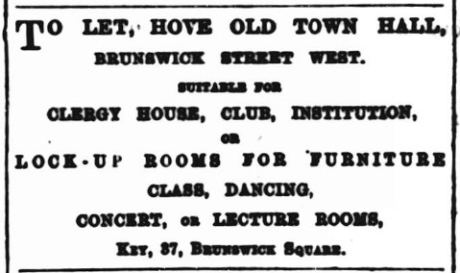
Brighton Gazette 15 Jun 1886 advertising Hove Old Town Hall to let
Hove Town Hall had moved to Church Road and by the 1880’s Number 1 Brunswick Street West (by then sometimes referred to as The Old Town Hall) was a large and rather grand building in search of a new purpose and - eventually - it got one.
The Brighton Pelican Club was founded in November 1888 by the very “genial” Mr T. Nelson Welling. Under his proprietorship the Club had thrived and grown into a humming social club with the “merriest of clubites” and well known for its social gatherings. There were “red letter days”, “smoking concerts”, “picnics, balls and dinners”.
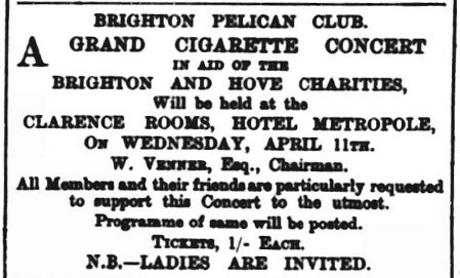
Brighton Gazette - Thursday 29 March 1894
A particularly significant event was held on the 22nd February, 1894: it was the Club’s 5th Annual Dinner. Over a hundred people attended (all men) and the well laden benches were “groaning under the burden of tempting dishes” and the “choicest of wines”. The feasting and carousing was interspersed with frequent toasts and “war cries” from loyal Pelicans. The dinner itself concluded with the singing of a Grace sung by, Mr Welling’s daughter, Edith (so there was at least one woman present - however briefly). Then the men got down to business: an important speech about the Club’s future. Nelson Welling explained – it was an open secret – that the Club was to be incorporated and henceforth known as “The Brighton Pelican Club Ltd”.

Brighton Gazette - Thursday 26 July 1894 - Pelican Club launch
A Board of Directors was already in place and 2,500 £1 shares were available for purchase. The old lease on the building had expired but a new 14 year lease had been negotiated with the Landlord and there were already big plans for improvements: a Billiards Room, a Smoking Room and a Lounge “furnished sumptuously in Japanese style”. The Chairman of the new Club retained 1000 of the shares but by the time the party broke up “in the early hours” many of the other £1 shares had been sold.
It is unclear to what extent those improvements actually took place but Pelican Club Ltd. seems to have flourished for a while although it did not last 14 years. By 1901 it had morphed into the Brunswick Club and following membership and licensing problems finally closed its doors on the last day of December, 1903.
The 20th Century
Buildings reflect their times. The character of 19th century Brunswick Street West was shaped by horse transport. The majority of its buildings were domestic stables, livery stables, Hackney Carriage companies and so on but by the pre-war years, the horse was no longer the undisputed king. This was reflected in the new use for “The Old Hove Town Hall” as it was often dubbed. After a period serving as auction rooms, by 1912 the building had become the premises of The Brighton Motor Mart Garage. There seems something symbolic about this change of use in a street whose 19th Century raison d’etre was horse transport. The BMM remained there during the war years and even later – in the 1920s – the building was leased by various motor engineer companies.
There was an interesting juxtaposition within the building. If the ground floor businesses could be said to serving mammon, the first-floor rooms seem to have served a more spiritual purpose. Before the war the upstairs rooms housed “The First Society of Spiritualists” and its Secretary, Mr. Alfred Cape. The Society of Spiritualists had its roots in 19th century America but by the early 20th century had spread to Britain. They shared broad religious principles and a basic belief in the continuous existence of the human soul. The Society seems to have been particularly strong in Brighton and Hove and to this day its successors are still to be found in their Edward Street Church.
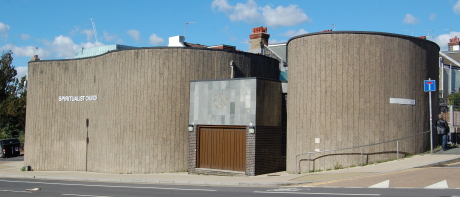
Brighton National Spiritualist Church, Edward Street, Brighton
That first floor was also used as the base for “The Catholic Women’s League” and its secretary: Mrs. St. George-Saunders. The Catholic Women’s League had been founded in 1906 following a conference held in Brighton. It sought to bring what was described as “balanced common-sense” into a charitable organisation. Its mission statement was to “utilise the average woman in convincing the Catholic world that business-like methods…are excellent weapons in the service of God”. It seems that Mrs. St. George-Saunders and her cohorts were committed to a more sensible, more methodical and – explicitly - more feminist approach to the management of charitable works.
The fact that the Brighton branch of a national religious organisation shared premises with a car show room was indicative of how the purpose of this building had changed during the (slightly less than) first century of its life. A building whose purpose had been to organise, administer and maintain the safety of the Brunswick Town residents now had to find other commercial functions. That was to be the pattern for the second century of its life.
Research by David Jackson (July 2022)
Discover the history of 20 Brunswick Street West
Return to Brunswick Street West page


